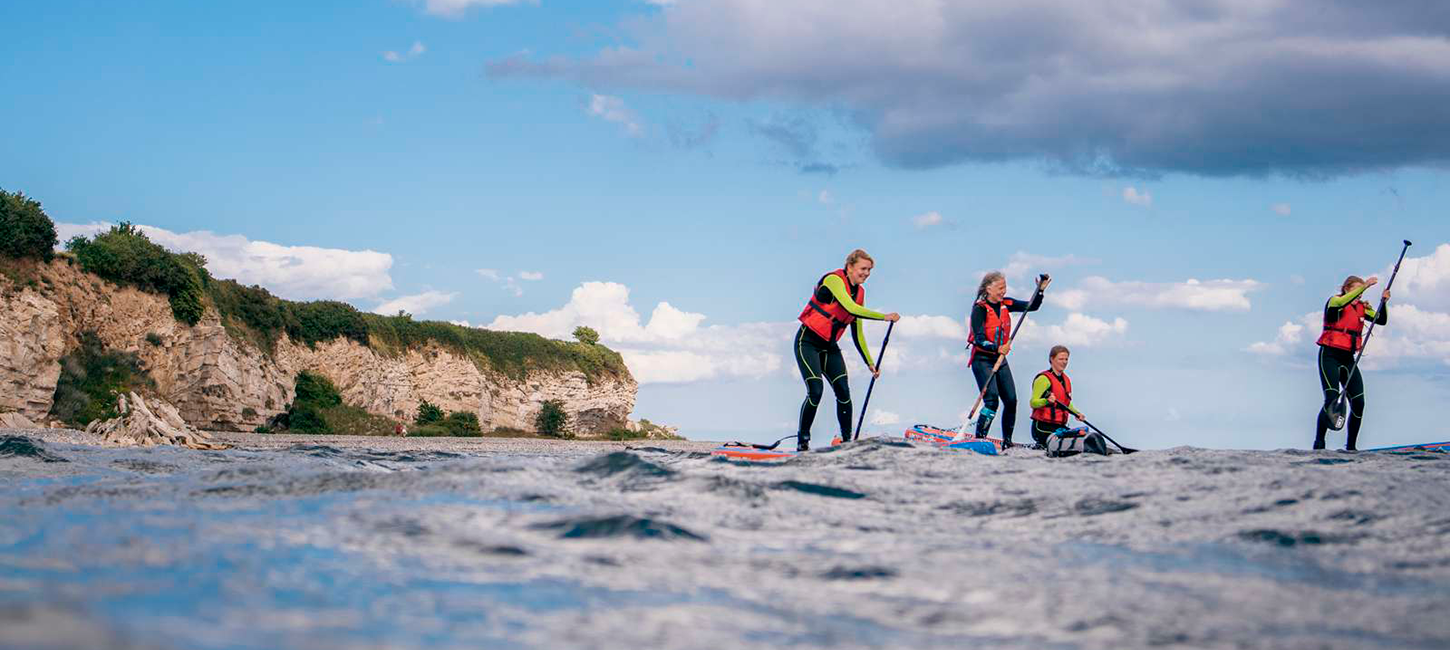
Go on a SUP tour along Stevns Klint and see the Stevnsfort fortress from the water
The tour begins on the beach in Rødvig, and you won’t have to paddle far to the east before you pass the mouth of the harbour and spot Stevns Klint glittering on the horizon. You’ll soon pass Rødvig’s landmark, the flint oven, which stands as a reminder of the production of flint dust.
As you paddle, you’ll move closer to the white cliff that rises abruptly from the clear waters of the Baltic Sea. Streaks of flint deposit can clearly be seen in the cliff, and if you paddle closer, you may be able to locate the 5–10 cm wide streak known as fish clay, which separates chalk and limestone in the cliff. The fish clay is the result of a massive meteor impact that hit Earth more than 66 million years ago and led to the extinction of the dinosaurs; in fact, half of all life on earth perished. The fish clay is more visible in Stevns Klint than anywhere else on Earth, and this is what led UNESCO to designate Stevns Klint as a world heritage site. A SUP board allows you to get right up close for a better look.
And don’t forget to look down, too, because on a good day the water here is as clear as if you were in the Caribbean – and you can easily see the seabed 4–6 metres below you.
Stop at Boesdal Quarry
After a few kilometres, you’ll have completed the first leg, and you can dock your board on the beach below Boesdal Quarry. Limestone was quarried here from the 1920s until 1978. It is one of the few places along the cliff where you can come ashore and reach the top of the cliff. Inside the limestone quarry is an impressive pyramid, which was used to store the crushed limestone. Use this break to explore the visitor centre (opening autumn 2022) or buy a refreshment at Boesdals Is og Cafe.
Once you are back on the board, the tour continues to the northeast along the cliff and out to the open sea. You can feel the power of nature when the swells crash against the steep cliff. If the wind is blowing from the southeast, you should consider whether you have sufficient SUP skills for paddling on the open sea. If the weather is calm, you can really feel close to the elements and far from civilisation with the steep cliff on one side and the open sea on the other.
Frogmen from the East
For the onward tour, there are few places to come ashore. But keep an eye out! Hidden in the cliff, you will suddenly spot a small jetty. This is Stevnsfort, one of Denmark and NATO’s most important positions during the Cold War. The fortress was carved into the cliff at the beginning of the 1950s and protected the entrance to the Sound. In the event of the Cold War heating up, two large cannons on the cliff could fire at enemy vessels. In peacetime, all shipping traffic was monitored from the underground fortress. Today, Stevnsfort is a museum, and if you arrive from land, you can go on a guided tour of the underground passages.
If you’re approaching from the water, you’ll need to dock at the jetty and take a break – and perhaps you’ll surprise a museum visitor who has made their way through the fortress corridors down to the jetty. During the Cold War, the stationed soldiers at the fortress were surprised when someone – probably frogmen from the Eastern Bloc – put a bottle of Polish vodka on the bridge under the cover of night. Perhaps it was just to demonstrate that they knew very well what the cliff was hiding.
It is tempting to continue north-east along the cliff, up to Stevns Lighthouse and on to Højerup Old Church – but be aware that it is a demanding trip that is best taken in the company of experienced paddlers with good local knowledge. You will also need to save some energy for the trip back to Rødvig, which takes a little over an hour, depending on the wind and the weather.
Practical information
Distance: 6–6.5 km round trip
Difficulty level: Medium – Difficult
Duration: 1½–2½ hours + breaks
Be aware of:
- Wind and weather. Stevns Klint is magnificent, but the waters near the cliff can be treacherous. Swells and waves from the Baltic Sea can be quite large, and there can also be quite a current. In the case of westerly winds, keep in mind that you will have the wind at your back on the way out, so save enough energy for the return journey against the wind. In the case of westerly winds, you must also ensure you do not drift too far away from the coastline.
- The fairway. Look carefully and cross just above the fairway at the mouth of the harbour in Rødvig.
- Landing conditions. There are limited opportunities to come ashore along Stevns Klint. You can dock on the stone beach at Boesdal Quarry and reach the top of the cliff, and there is a jetty below Stevnsfort where you can dock your SUP board.
- Mobile coverage. Not all places along the cliff have mobile coverage, so remember to check the weather forecast before you set off.
- Guided tours: Limelight Watersports offers guided tours of Stevns Klint for all levels.
What to bring:
- Dress for the water temperature; the water and wind will quickly cool you down even when the sun is shining. Please wear a wetsuit.
- Mobile phone in a waterproof bag
- Life jacket (on the body)
- Sunscreen
- Water and snacks